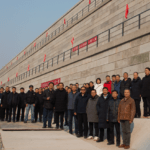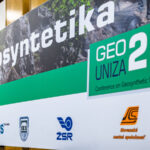THE CHALLENGE 
In August of 2015, Cherokee Builders began construction of a trucking and crane storage yard expansion for Northwest Crane in Hectorville, OK. The geotechnical report was from the original lot that had previously been constructed but needed to be expanded. That report determined that the subgrade, at most locations, would consist of low strength silt underlain by moderate strength and lean to fat clays with varying amounts of gravel. The report determined that the silty soils were not suitable for supporting surfacing materials and the clay soils were subject to volume change and strength loss with variations in moisture content. Because of the variation in composition of the subgrade soils, and the potential for strength loss with variation in moisture content, the geotechnical engineer recommended the subgrade be modified with 9 inches of fly ash, prior to placement of 6 inches of aggregate base surfacing.
The contractor treated the first 2 acres of the project site with fly ash and was able to stabilize the soils. As they continued, the soil conditions got worse and the fly ash was not able to stabilize the existing subgrade. The contractor had previously utilized TenCate Mirafi® RS580i woven geosynthetic on another project with great success and decided to recommend it on this project in lieu of fly ash.
THE DESIGN
TenCate’s Miraspec design software was utilized by TenCate engineers to develop a stabilization section for the existing soils. Because the on-site soils were much worse than anticipated, the contractor and owner, together, decided to build a test section to verify TenCate’s design and see if they could thin up the aggregate requirement or utilize a lighterweight geotextile than calculated. The resulting design was 8 inches of aggregate base course to be placed over one layer of Mirafi® RS580i geosynthetic. The owner chose to go with Mirafi® RS580i, versus the lighter-weight Mirafi® RS380i, in order to provide additional reinforcement for the anticipated heavy loads and to provide an additional factor of safety.te of installation April 2015
THE CONSTRUCTION
Due to final grade requirements, prior to the placement of Mirafi® RS580i, the contractor had to remove 1 inch of the weak onsite soils across the site. Had there not been a grade requirement, the recommendation would have been to place the Mirafi® RS580i directly onto the subgrade.
The contractor installed Mirafi® RS580i with ease, maintaining 2 feet of overlap across the site. By utilizing a geosynthetic-reinforced section, versus chemical stabilization, the contractor was able to achieve a consistent stabilization section and a reduced construction schedule by not having to wait on cure time.
 |
 |
| Working the subgrade before placement of Mirafi® RS580i geosynthetic | Bridging soft soils and building the platform |
THE PERFORMANCE
Because chemical stabilization did not work, the contractor had no choice but to employ another means of stabilizing the site. The owner performed a cost comparison and determined that the cost of the Mirafi® RS580i section was comparable to the cost of the chemically stabilized section, thereby fitting within their budget constraints.
Three weeks after construction started, the owner wanted to truly see how well the section was going to hold up. So, they set up a crane in a few spots across the site and observed minimal, if any, deflection from the outriggers. All parties involved were very happy with the overall performance of the composite Mirafi® RS580i and aggregate section.
Further Information
For more information visit www.mirafi.com






















